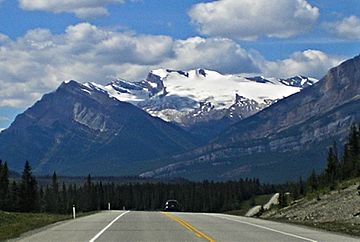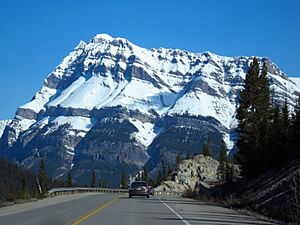Mount Wilson (Alberta) facts for kids
Quick facts for kids Mount Wilson |
|
|---|---|

Mount Wilson and Wilson Icefield seen from the David Thompson Highway
|
|
| Highest point | |
| Elevation | 3,260 m (10,700 ft) |
| Prominence | 780 m (2,560 ft) |
| Parent peak | Mount Cline (3361 m) |
| Listing | Mountains of Alberta |
| Geography | |
| Location | Alberta, Canada |
| Parent range | Cline Range Canadian Rockies |
| Topo map | NTS 83C/02 |
| Type of rock | Sedimentary |
| Climbing | |
| First ascent | 1902 by Outram and Kaufmann |
| Easiest route | technical climb |
Mount Wilson is a tall mountain in Banff National Park, Alberta, Canada. It stands 3,260-metre (10,696 ft) high in the North Saskatchewan River valley. This mountain is part of the Canadian Rockies. Its closest taller neighbor is Mount Cline, about 9.81 km (6.10 mi) away.
Mount Wilson is easy to spot near Saskatchewan Crossing. This is where the Icefields Parkway meets the David Thompson Highway. It's also where the North Saskatchewan, Mistaya, and Howse rivers join together.
Contents
History of Mount Wilson
Mount Wilson is named after Tom Wilson (1859–1933). He was an early explorer who traveled a lot in the Canadian Rockies. The mountain got its name in 1898 from Norman Collie.
The first people to climb to the top of Mount Wilson were James Outram and Christian Kaufmann. They reached the summit in 1902. The name "Mount Wilson" became official in 1924. This was decided by the Geographical Names Board of Canada.
How Mount Wilson Was Formed
Like other mountains in Banff Park, Mount Wilson is made of sedimentary rock. This type of rock forms from layers of sand, mud, and shells that build up over millions of years. These layers were laid down in shallow seas a very long time ago. This happened from the Precambrian to the Jurassic periods.
Later, during a time called the Laramide orogeny, these rock layers were pushed up. They moved east and slid over younger rocks. This process created the tall mountains we see today. The west and south sides of Mount Wilson have rough, rocky cliffs. But the north and east sides are covered by a large sheet of ice. This ice sheet is called the Wilson Icefield.
Mount Wilson's Climate and Weather
Mount Wilson is in a subarctic climate zone. This means it has very cold and snowy winters. The summers are usually mild. Temperatures can drop below −20 °C (−4 °F). With the wind, it can feel even colder, sometimes below −30 °C (−22 °F).
The cold winter weather makes Mount Wilson a great place for ice climbing. Many people come here to climb the frozen waterfalls. All the rain and snow that falls on Mount Wilson eventually flows into the Saskatchewan River.
Ice Climbing Routes on Mount Wilson
Mount Wilson is famous for its challenging ice climbing routes. Here are some of the routes and their difficulty grades:
- Dancing With Chaos – WI6
- Midnight Rambler – WI3
- Wilson Major – WI3-6
- Lady Wilson's Right Tit – WI4
- Totem Pole – WI5
- Living in Paradise – WI6+
- Suntori – WI6
- Skinny Puppy – WI5
- Phil Spectre's Nightmare – WI6
- Mixed Monster – M8 WI5+
Gallery






